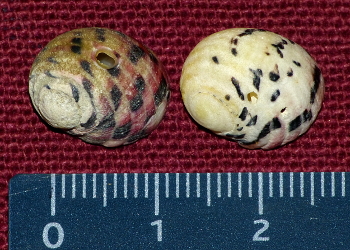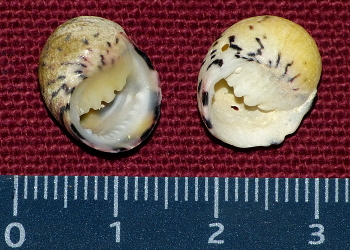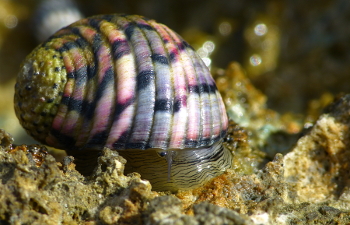This post is also available in: Dutch (below)
First published on December 24, 2013


Marine snails which are part of the Nerite family often have small teethlike protrusions which can often be found on the mouth plate (columella fold), the calcerous part at the opening at the bottom of the shell where the slug’s body moves to the outside. In the Caribbean Four-tooth Nerite or Nerita versicolor four teeth can be observed at the aperture and there are also several smaller ones on the outer lip. The shell colors are very diverse and range from cream to brown with various checkered patterns and as such can make identifying the species from above quit hard. The animals are not rare, and usually you will find several individuals together on limestone rocks lying in the surf on the south coast and north coast of the island of Curaçao as well as Bonaire and Aruba. They can withstand periods of drying out and are therefore often found on stones which have dried out after a few hours of low tide. The snails are not active during the day, and only go in search for food in the evenings.

The Four-tooth Nerite is considered mature when it has a size of 16 to 19 millimeters and usually will not grow larger than 25 millimeters. The animals can reproduce throughout the year. Males fertilize the females with sperm packets which are stored by the females for later use.
The species can be found throughout the Caribbean and can also be found in Florida and Bermuda.
English name: Caribbean Four-tooth Nerite
Papiamentu name: –
Scientific name: Nerita versicolor
Family: Neritidae (Nerites)
Occurrence (ABC islands): Aruba, Bonaire and Curaçao

Schelpen: Caribische viertandneriet


In de mondplaat, de opening aan de onderkant van de schelp waar het slakkenlichaam zich naar buiten beweegt, van de Neritaslakken zijn vaak een soort tandjes waar te nemen, uitsteeksels in de vorm van kleine tandjes. Bij de Caribische viertandneriet of Nerita versicolor zijn er 4 tandjes waar te nemen bij de mondplaat en zijn er ook op de buitenlip tandjes te zien. De kleuren variëren van crèmekleurig tot bruin met verschillende geblokte patronen. De dieren zijn niet zeldzaam en meestal vindt je er verschillende samen op kalkrotsen die in de branding aan de zuidkust en noordkust van het eiland (Curacao, Aruba en Bonaire) liggen. Ze kunnen goed tegen de droogte en zijn dan ook vaak te vinden op stenen die een paar uur droog komen te liggen als het eb wordt. Overdag zijn de slakken niet actief en gaan pas op zoek naar voedsel in de avonduren.

De Viertandneriet wordt als volwassen gezien wanneer het 16 tot 19 millimeter groot is en wordt meestal niet groter dan 25 millimeter. De dieren kunnen zich gedurende het hele jaar voortplanten. De mannetjes bevruchten de vrouwtjes met sperma pakketjes die de vrouwtjes op hun beurt weer opslaan voor later gebruik.
De soort komt in het Caribisch gebied voor en is ook te vinden bij Florida en Bermuda.
Nederlandse naam: Caribische viertandneriet
Papiamentse naam: –
Wetenschappelijke naam: Nerita versicolor
Family: Neritidae (Nerieten)
Voorkomen (ABC eilanden): Aruba, Bonaire en Curaçao